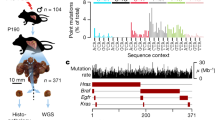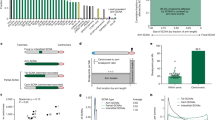Abstract
Two hypotheses have been advanced to suggest how radiation may produce chromosome aberrations. The classical “breakage-first” hypothesis due to Sax1 and others (reviewed in ref. 2) is that the initial lesion is a break in the chromosome. The two ends produced may then (1) rejoin in the original configuration (restitution); (2) rejoin “illegitimately” with other ends produced by another break to form an exchange; or (3) remain unjoined to form a terminal deletion. Revell's exchange hypothesis3 is that all chromatid aberrations are exchanges produced by the interaction of two lesions (not breaks). The aberrations involving only one chromosome are produced only at the point of overlap where the chromosome is looped back on itself. The two proposals differ principally in that the exchange hypothesis proposes (1) that the initial lesion is not a break, (2) that all aberrations are exchanges involving two lesions, and (3) that all aberrations except exchanges between different chromosomes are formed at the point of overlap where the chromosome is in a loop. Chromatid deletions, which are unrejoined breaks on the breakage-first hypothesis, in Revell's hypothesis result from the failure to complete an exchange at the point of overlap of a loop in the way known to occur frequently when exchanges are produced between chromosomes. Attempts to distinguish between these two hypotheses have centred on the relative frequencies of the different kinds of aberrations and on the dose response relationships. Results have been equivocal: some of the data do not agree with the simple statements of either the breakage-first4–7 or the exchange hypotheses8–12. We report here a more direct test of the differences between the two hypotheses. We have not explored the nature of the initial lesion, but have shown that many terminal deletions are actually incomplete exchanges. The data agree both qualitatively and quantitatively with Revell's exchange hypothesis.
This is a preview of subscription content, access via your institution
Access options
Subscribe to this journal
Receive 51 print issues and online access
$199.00 per year
only $3.90 per issue
Buy this article
- Purchase on Springer Link
- Instant access to full article PDF
Prices may be subject to local taxes which are calculated during checkout
Similar content being viewed by others
References
Sax, K., Genetics, 23, 494 (1938).
Lea, D. E., Actions of Radiations on Living Cells (Cambridge Univ. Press, 1955).
Revell, S. H., in Proc. Radiobiol. Symp., Liège, 243 (Butterworth, London, 1954).
Revell, S. H., Mutation Res., 3, 34 (1966).
Grant, C. J., Mutation Res., 2, 247 (1965).
Neary, G. J., in Radiation Research 1966, 445 (North-Holland, Amsterdam, 1967).
Brewen, J. G., Proc. US Nat. Acad. Sci., 50, 322 (1963).
Brewen, J. G., Mutation Res., 1, 400 (1964).
Scott, D., and Evans, H. J., Mutation Res., 4, 579 (1967).
Wolff, S., in Cellular Radiation Biology, 167 (The Williams and Wilkins Co., Baltimore, 1965).
Evans, H. J., and Scott, D., Genetics, 49, 17 (1964).
Savage, J. R. K., Preston, R. J., and Neary, G. J., Mutation Res., 5, 47 (1968).
Taylor, J. H., Woods, P. S., and Hughes, W. L., Proc. US Nat. Acad. Sci., 43, 122 (1957).
Taylor, J. H., Genetics, 43, 515 (1958).
Revell, S. H., Proc. Roy. Soc., B, 150, 563 (1959).
Brewen, J. G., and Brock, R., Mutation Res. (in the press).
Demin, Y. S., Sidorov, B. N., and Sokolov, N. N., Genetika, 1967, 10 (1967).
Conger, A. D., Mutation Res., 4, 449 (1967).
Author information
Authors and Affiliations
Rights and permissions
About this article
Cite this article
HEDDLE, J., WHISSELL, D. & BODYCOTE, D. Changes in Chromosome Structure induced by Radiations: a Test of the Two Chief Hypotheses. Nature 221, 1158–1160 (1969). https://doi.org/10.1038/2211158a0
Received:
Revised:
Issue Date:
DOI: https://doi.org/10.1038/2211158a0
This article is cited by
Comments
By submitting a comment you agree to abide by our Terms and Community Guidelines. If you find something abusive or that does not comply with our terms or guidelines please flag it as inappropriate.



